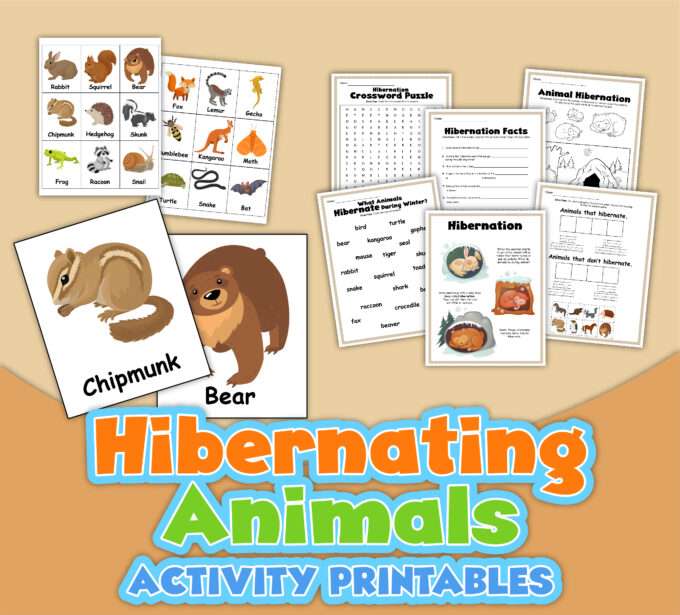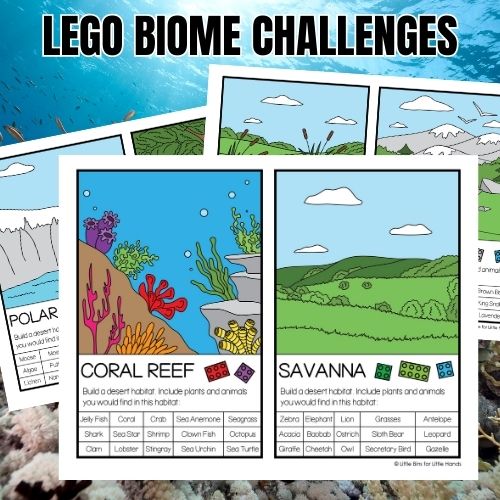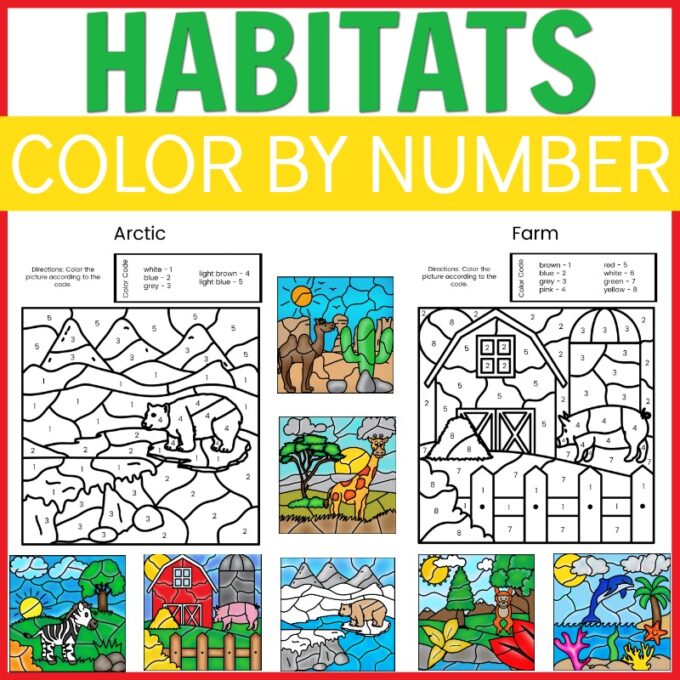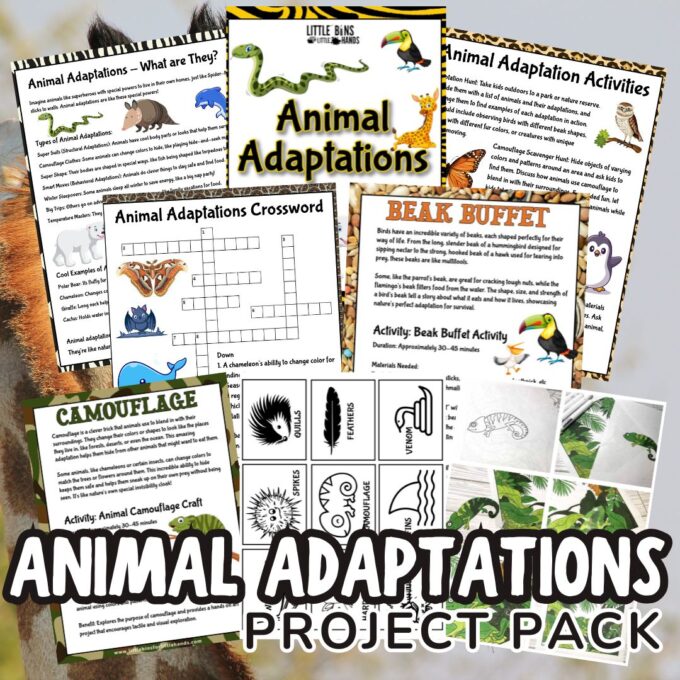Welcome to the fascinating world of animal migration! Have you ever wondered why birds fly south for the winter or how fish find their way across vast oceans? Migration is one of nature’s most incredible journeys, where animals travel thousands of miles to find food, reproduce, or escape harsh weather conditions. Don’t forget to download our free migration activities guide, which is packed with exciting facts and examples!

What Is Animal Migration?
Migration is the seasonal movement of animals from one place to another. It’s a remarkable behavior observed in various species across the globe.
But why do animals migrate? Several reasons include finding food, breeding, avoiding predators, or seeking more suitable climate conditions. Migration is a critical survival strategy that ensures the well-being and continuity of many species. Find fun and easy-to-do migration activities for kids below.
Make sure to look through all of our Biology Activities for Kids here.
Fun Animal Migration Activities For Kids
Our free animal migration activities pack for kids includes three fun activities for learning about migrating animals: a creative writing postcard activity, a research project outline, and a word search! By completing these migration activities, you’ll gain a deeper understanding of the fascinating world of wildlife migration and become a true explorer of the natural world.
Free Animal Migration Activities Guide
Don’t forget to download our free migration activities and information printable to delve deeper into the world of migration with fun facts, examples, and activities.
Creative Writing: Migration Activities Bird Postcard
Imagine you’re a migrating bird embarking on an incredible journey across continents. Now, it’s time to share your adventures with a non-migrating bird friend through a migration postcard! Here’s how to get started:
Step 1: Choose a Migrating Bird: Select a migratory bird species that interests you. It could be the majestic Arctic tern, the colorful painted bunting, or any bird known for its remarkable migration.
Step 2: Research the Bird’s Migration Journey: Learn about the bird’s migration route, including its starting point, destination, key stopover sites, and any interesting facts about its journey. You can gather information from books, websites, or nature documentaries.
Step 3: Create Your Postcard: Use the postcard template provided in the printable to design your migration postcard. Include a colorful illustration of the bird and its migration route map, and write a message to your non-migrating bird friend describing your adventures, challenges, and exciting discoveries.

Migration Activities Observation Log
Embark on a scientific exploration of wildlife migration by filling out a migration observation log. Choose a migrating animal to learn more about and document its migration pattern. Here’s how to get started:
Step 1: Choose a Migrating Animal: Select a migrating animal that captures your interest. It could be a bird, fish, insect, mammal, or marine animal. Consider species like monarch butterflies, Pacific salmon, caribou, or humpback whales.
Step 2: Research the Animal’s Migration Pattern: Learn about the chosen animal’s migration habits, including its starting point, destination, timing of migration, and any noteworthy behaviors or adaptations associated with its journey. Use reliable resources such as books, websites, or scientific journals to gather information.
Step 3: Fill Out the Migration Observation Log: Use the provided migration observation log template in the printable to record your findings. Include details such as the species name, migration route, distance traveled, migration triggers, and any observations you make during your research.
Step 4: Reflect and Learn: Take some time to reflect on what you’ve learned about wildlife migration through your research and observations. Consider animals’ challenges during migration and the importance of conservation efforts to protect their habitats and migration routes.

Migration Activities Matching Game
Here is another fun migration activities game. Turning the below list of migrating animals and their migration patterns into a matching game will provide elementary school kids with a fun and interactive way to learn about wildlife migration. Grab the free printable migration matching game to play with your kids!
Matching Game Materials Needed:
- Printouts of animal cards (one set with animal names, one set with migration patterns)
- Large poster board or table area
- Glue or tape
Matching Game Instructions:
STEP 1. Prepare the Migration Matching Cards: Print out two sets of animal cards: one with the names of migrating animals and another with their corresponding migration patterns.
STEP 2. Set Up the Game Area: Lay out the animal cards with names in one row or column and the migration pattern cards in another row or column on a large poster board or display area. Leave enough space between the cards for matching pairs to be placed side by side.
STEP 3. Introduce the Game: Gather the kids and introduce the matching game. Explain that they will match migrating animals with their corresponding patterns to learn about wildlife migration.
STEP 4. Demonstrate How to Play: Demonstrate how to play the game by selecting an animal card and reading its name. Then, choose a migration pattern card and read it aloud. Encourage the kids to think critically and match the animal card with the correct migration pattern card based on their knowledge or guesses.
STEP 5. Time To Play: Divide the kids into small groups or pairs and allow them to take turns playing the matching game.
STEP 6. Reinforce Learning: After each match is made, reinforce learning by discussing the migration pattern of the matched animal. Encourage the kids to ask questions and share their thoughts about wildlife migration.
Extension Activities:
- To extend the activity, encourage the kids to create their own animal cards and migration pattern cards for additional species.
- Encourage creative expression by having the kids draw illustrations or write short descriptions of each animal’s migration journey.
Animals That Migrate
Migrating Birds
Bird migration is perhaps one of the most well-known examples of animal migration. Millions of birds undertake incredible journeys every year, traveling thousands of miles between their breeding and wintering grounds.
For instance, the Arctic Tern holds the record for the longest migration, covering up to 71,000 kilometers round trip! These birds navigate using a combination of celestial cues, landmarks, and magnetic fields.
Species like the colorful warblers and majestic raptors provide excellent opportunities for birdwatchers to witness this phenomenon firsthand.
Migrating Fish
Did you know that some fish migrate just like birds? From salmon swimming upstream to spawn to the awe-inspiring journeys of the massive whale sharks. Fish migration spans freshwater rivers, oceans, and everything in between.
Take the Pacific salmon, for example. Born in freshwater rivers, they migrate to the sea to grow and mature before returning to their natal streams to reproduce. This cyclical journey plays a vital role in maintaining the health of both freshwater and marine ecosystems.
Migrating Insects
Insects may seem small, but their migration journeys can be equally impressive. The monarch butterfly, famous for its vibrant orange and black wings, travels thousands of miles from Canada and the United States to central Mexico for the winter. This epic migration involves multiple generations of butterflies, with each generation participating in the journey.
Other insects, like the globe skimmer dragonfly, embark on long-distance flights across continents!
Migrating Mammals
Mammals exhibit amazing migration patterns, from herds of wildebeest thundering across the African savannah to the gentle giants of the ocean, such as humpback whales.
Land mammals often migrate for food or to give birth in safer environments. The caribou, also known as reindeer, undertake one of the longest overland migrations, traveling thousands of kilometers across the Arctic tundra.
Migrating Marine Animals
The world beneath the waves is teeming with life, including some of the most extraordinary migratory journeys on the planet. Marine animals like sea turtles, seals, and whales travel vast distances across oceans, following migratory routes ingrained in their instincts for generations.
For instance, the leatherback sea turtle travels thousands of kilometers to lay its eggs on sandy beaches before returning to the ocean’s depths.



When Do Animals Migrate?
Animals migrate at specific times of the year, often in response to changes in temperature, daylight hours, and food availability.
Many birds migrate during spring and fall, undertaking long journeys between breeding and wintering grounds. Spring migration, typically between March and June in the Northern Hemisphere, sees birds heading north to breed in temperate regions. While fall migration between August and November sees them returning south to escape colder weather.
Fish also migrate seasonally, with species like salmon migrating upstream to spawn during the spring and summer months. Insects may also migrate during specific seasons, such as monarch butterflies undertaking their fall migration from September to November.
Both terrestrial and marine mammals may migrate at various times of the year depending on factors like mating seasons, food availability, and weather conditions. Overall, the timing of animal migration is intricately linked to seasonal changes, ensuring countless species’ survival and reproductive success.
Where Do Animals Migrate?
Animals migrate to various places around the world depending on their species, habitat requirements, and seasonal needs. Birds often migrate between breeding and wintering grounds. They traverse continents and hemispheres to find milder climates and abundant food sources.
Fish undertake migrations between freshwater rivers and the ocean, traveling upstream to spawning grounds or downstream to feeding areas.
Mammals migrate across diverse landscapes, including land-dwellers like wildebeest and marine giants like whales. They search for resources and suitable breeding sites, from savannahs to ocean basins.
Insects like butterflies embark on long-distance flights across continents. Meanwhile, marine animals like sea turtles and seals migrate between nesting beaches and foraging grounds in oceans and seas.
Whether soaring through the skies, swimming through oceans, or trekking across vast landscapes, animals embark on epic journeys that connect ecosystems and shape the natural world.
More Animal Activities to Explore
- Hibernating Animals
- Animal Adaptations
- Biomes Lapbook
- LEGO Biome Challenges
- Continents and Animals
- Animal Habitat Color By Number
- Bird Activity Pack
- Australian Animal Activities






Printable Animal Adaptations Activities Pack
Suitable for elementary-age students at home or in the classroom!
Discover the wonders of the animal kingdom with our engaging Animal Adaptations Activity Pack! Packed with hands-on activities like the Beak Buffet and Camouflage Collage, your students will dive into how animals adapt to their environments.
From fun crosswords and word searches to informative sheets and interactive fill-in-the-blanks, this pack is designed to make learning about animal adaptations fun and educational. Bring the excitement of the natural world into your classroom today!
Explore the fascinating world of animal adaptations with our comprehensive Activity Pack, featuring:
- Beak Buffet: Discover how different beak shapes are adapted for specific diets.
- Camouflage Collage: Unveil the art of blending in with surroundings through a hands-on collage activity.
- Challenging Crosswords and Word Searches: Test knowledge while having fun with interactive puzzles.
- Informative Sheets: Dive deep into the science behind various animal adaptations with our informational resources.
- Interactive Fill-in-the-Blanks: Engage students with interactive worksheets that reinforce key concepts.
- And much more! Our pack ensures an enriching learning experience for all with a variety of activities to choose from.










